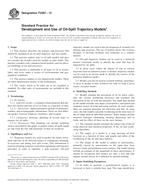We need your consent to use the individual data so that you can see information about your interests, among other things. Click "OK" to give your consent.
ASTM F2067-13
Standard Practice for Development and Use of Oil-Spill Trajectory Models
STANDARD published on 1.4.2013
The information about the standard:
Designation standards: ASTM F2067-13
Note: WITHDRAWN
Publication date standards: 1.4.2013
SKU: NS-52664
The number of pages: 3
Approximate weight : 9 g (0.02 lbs)
Country: American technical standard
Category: Technical standards ASTM
The category - similar standards:
Annotation of standard text ASTM F2067-13 :
Keywords:
computer-based model, fate and weathering model, oil spill surveillance and tracking, oil spill trajectory, ICS Number Code 75.180.10 (Exploratory, drilling and extraction equipment)
Additional information
| Significance and Use |
|
3.1 Trajectory models are used to predict the future movement and fate of oil (forecast mode) in contingency planning, in exercises and during real spill events. This information is used for planning purposes to position equipment and response personnel in order to optimize a spill response. Oil-spill trajectory models are used in the development of scenarios for training and exercises. The use of models allows the scenario designer to develop incidents and situations in a realistic manner. 3.2 Oil-spill trajectory models can be used in a statistical manner (stochastic mode) to identify the areas that may be impacted by oil spills. 3.3 In those cases where the degree of risk at various locations from an unknown source is needed, trajectory models can be used in an inverse mode to identify the sources of the pollution (hindcast mode). 3.4 Models can also be used to examine habitats, shorelines, or areas to predict if they would be hit with oil from a given source (receptor mode). |
| 1. Scope |
|
1.1 This practice describes the features and processes that should be included in an oil-spill trajectory and fate model. 1.2 This practice applies only to oil-spill models and does not consider the broader need for models in other fields. This practice considers only computer-based models, and not physical modeling of oil-spill processes. 1.3 This practice is applicable to all types of oil in oceans, lakes, and rivers under a variety of environmental and geographical conditions. 1.4 This practice applies to two-dimensional models. There are three-dimensional models in the marketplace. 1.5 The values stated in SI units are to be regarded as standard. No other units of measurement are included in this standard. |
Similar standards:
1.12.2013
1.5.2014
1.11.2011
1.2.2006
1.1.2004
1.2.2007
We recommend:
Technical standards updating
Do you want to make sure you use only the valid technical standards?
We can offer you a solution which will provide you a monthly overview concerning the updating of standards which you use.
Would you like to know more? Look at this page.



 DIN CEN ISO/TR 13624..
DIN CEN ISO/TR 13624..
 Cookies
Cookies
